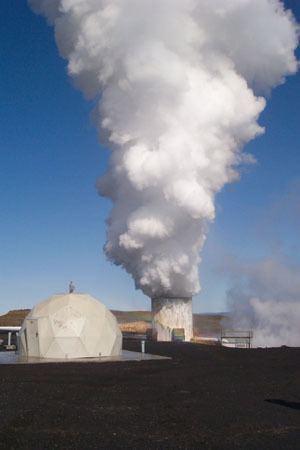 | ||
Due to the geological location of Iceland (over a rift in continental plates), the high concentration of volcanoes in the area is often an advantage in the generation of geothermal energy, the heating and making of electricity. During winter, pavements near these areas (such as Reykjavik and Akureyri) are heated up.
Five major geothermal power plants exist in Iceland, which produce approximately 26.2% (2010) of the nation's electricity. In addition, geothermal heating meets the heating and hot water requirements of approximately 87% of all buildings in Iceland. Apart from geothermal energy, 73.8% of the nation’s electricity is generated by hydro power, and 0.1% from fossil fuels.
Consumption of primary geothermal energy in 2004 was 79.7 petajoules (PJ), approximately 53.4% of the total national consumption of primary energy, 149.1 PJ. The corresponding share for hydro power was 17.2%, petroleum was 26.3%, and coal was 3%. Plans are underway to turn Iceland into a 100% fossil-fuel-free nation in the near future. For example, Iceland's abundant geothermal energy has enabled renewable energy initiatives, such as Carbon Recycling International's carbon dioxide to methanol fuel process. The following are the five largest power stations in Iceland.
- Hellisheiði Power Station (303 MW)
- Nesjavellir Geothermal Power Station (120 MW)
- Reykjanes Power Station (100 MW)
- Svartsengi Power Station (76.5 MW)
- Krafla Power Station (60 MW)
